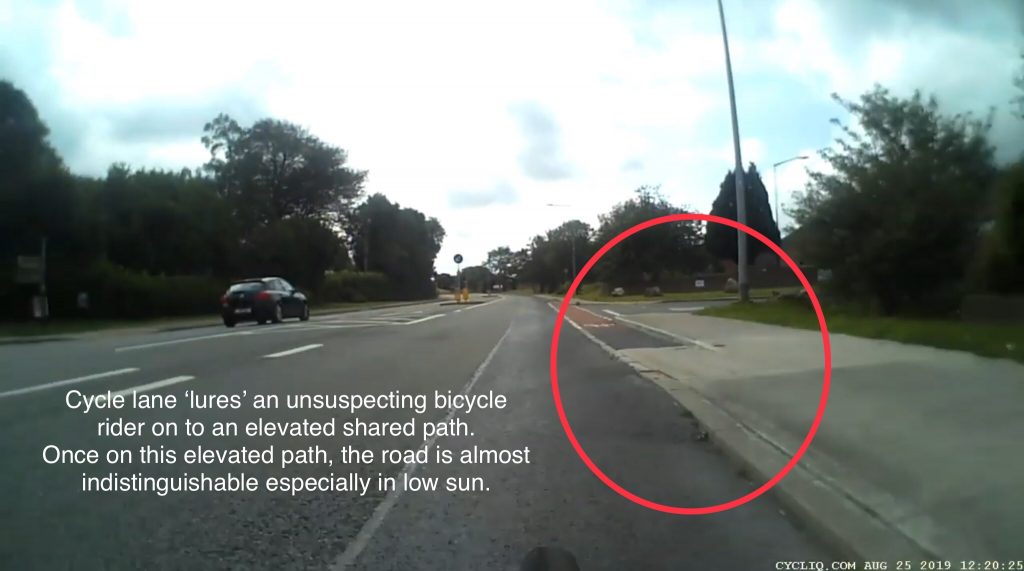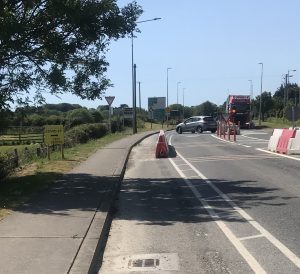
From the many complaints that I’ve heard over the years, the R730 Drinagh Northbound section from McDonalds to Kerlogue would be a worthy recipient for Wexford’s worst cycling project.
As some background, Wexford Co Co had rightly identified this road as ‘an area with almost complete dependency on car travel’
The solution was fairly simple and the associated submission secured a handsome fund of €648,100 for the project announced by the the Junior Transport Minister, Alan Kelly.
Simply put, the plan was:
- Replace a perfectly adequate hard-shoulder on the southbound section with a line of paint and call it a cycle lane
- Remove the relatively safe existing northbound cycle lane and replace it with a mixture of ramps, pedestrians, dogs, buses and bikes.
3. Reduce the speed limit.
4. Add non sheltered bus stops.
What could possibly go wrong..?!!
The speed limit and bus stops were relatively simplistic but the cycling infra was a different matter. While understanding the need for conflicting interests, it appears the needs of bicycle riders were not high on the list of priorities for this project.
This is a clip of what this road was like before the active travel project was carried out. You will see an existing cycle lane here.
Local Authorities in general, have a tendency to build woefully inadequate cycling infrastructure and Wexford Co Co has certainly enhanced that woefulness here, especially on the northbound side of the R730 in Drinagh.
When planning such infrastructure, roads engineers can’t seem to figure out what to do with bicycles. This means cycle lanes generally get shoved in to the gutter, run dangerously close to door zones or they are ‘lured on to the footpath with a mix of often confusing road markings and signage.
I’m an experienced cyclist and the Northbound, McDonalds to the Coolballow Rd., refit scared the life out of me, the first time I cycled along it –
In the glare of the sun it can be difficult to differentiate between the unpainted raised shared facility and the road and you arrive at this situation without warning..
Indeed there are times when doing nothing is much better than doing something, especially when that something has led to regular harassment along incidents requiring hospital admissions, not previously associated with a particular stretch of restructured roadway.
It gives me no pleasure to experience, see and hear from end user victims of this woeful inadequacy –
– The gentleman from Cork wincing in pain on an ED trolley recounting his experience of this.
He had been cycling along this stretch and not being familiar with the road was lured up one of the ramps and lost his bearings. Unsure as to whether he was on the shared path or on the roadway, the bike flipped over the path edge out on the main carriageway.
Luckily there wasn’t an oncoming car or maybe this was a different conversation.
- The lady from a local cycling club who had a similar collision and ended up requiring hospital treatment for a jaw and facial injury.
These are just those that I’ve heard of. There may be many more of course..
Punishment Passes
From my many visits to this area, the most common type of bike user are those with a road bike. With the associated prevailing tailwind, an average rider is going too fast for a path shared with long-lead dog walkers and earphone wearing, daydreaming pedestrians.
Bicycle riders are perfectly entitled to choose the alternative of using the main carriageway.
This is covered by traffic law and the rules of the road but from my experience not many road users seem to be aware of this.
I and many others I know have been on the receiving end of harassment and many punishment passes on this stretch.
These are easily identified by a loud horn blast followed by a close, overtaking manoeuvre.
People just seem to see a bike symbol on the road and expect that a rider must be there.
Without an awareness campaign explaining the reality of this, then it’s hard to cast blame on to the average driver.
None of these situations existed prior to the councils refit and importantly, no cyclist that I know asked for this to be put in place…it was foisted upon the areas bicycle riders, and make no mistake, this design leads to conflict.
Drinagh inadequacy flagged by local Councillors
This was flagged too by current Mayor George Lawlor, the then Mayor – Cllr Ger Carthy and former Cllr Claire wadding as recorded in the people newspaper in Feb. 2016. https://www.wexfordpeople.ie/news/lawlor-and-carthy-in-rare-agreement-34488981.html
I’m very disappointed with the work in Drinagh.We are possibly the leading county in Ireland in terms of safety for cyclists and headed up the (sic) Stayin’ Alive at 1.5 Campaign. We haven’t given as much as 1.5 cm for cyclists. It wasn’t our finest hour. Thousands of people avail of the Bike to Work scheme and I think the theme of the money used for the works was Active Travel. I think it was a poor day work.’We are sending out the wrong message’, he said.
George Lawlor Wexford Co councillor.
Let’s be clear here…The aim of Active Travel was to entice car users out of their vehicles on to more active modes such as walking and cycling. I’m not sure how the removal of a cycle lane could be seen as part of that process – to me that’s simply not logical!
This type of infrastructure, does little for increasing cycling mode and indeed may have had the unintended consequence of decreasing that mode due to the associated dangers and end user experience.
Here is a random video taken recently from this area.
You will see 3 riders on the footpath beside the southbound cycle lane.
These riders have made their own safety choice and the notional safety provided by sticking a different type of paint on the road has not had the desired effect to entice these riders in to the non protected cycle lane.
In all likelihood those who were OK with using the previous hard shoulder, are those who continue to use the cycle lane.
We need to start is to increase funding for connected cycling infrastructure greatly and do so on an ongoing basis with a grand plan in mind.
We need to stop rolling out landmark, costly unreasoned and sometimes, dangerous infrastructure.
Our key goals need to be safety, destination and connection – where the lane is going to and how it’s connected.



